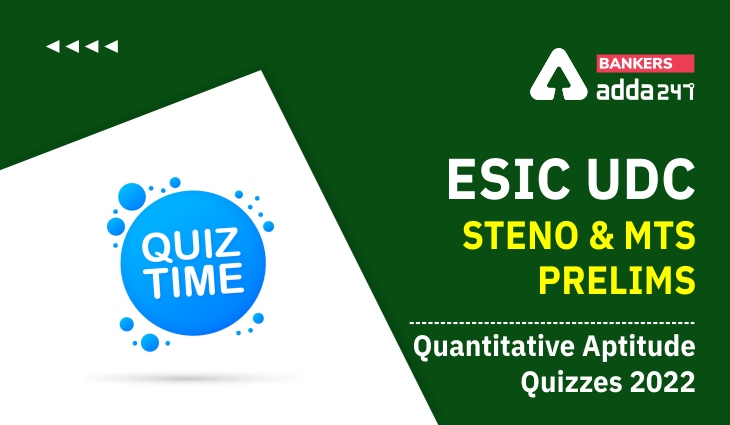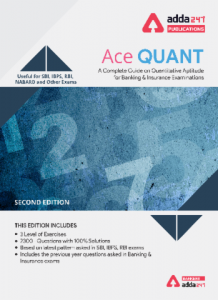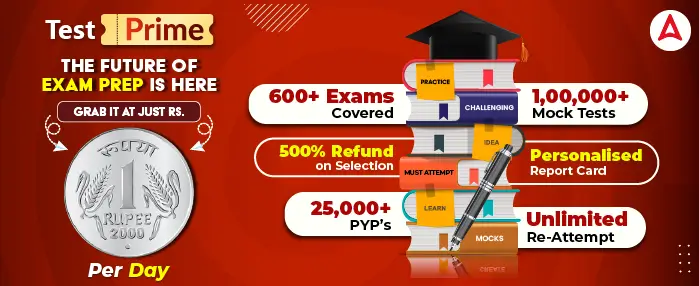Directions (1-10): Each question below contains two quantities, Quantity I and Quantity II. Find both, if needed, to know the relationship among them. Mark your answer accordingly.
Q1. Quantity I: Find the length of train running at 54 kmph which cross the platform of length 90 meters in 18 seconds. (in meters)
Quantity II: 185 meters
(a)Quantity I>Quantity II
(b)Quantity I<Quantity II
(c)Quantity I≥Quantity II
(d)Quantity I≤Quantity II
(e)Quantity I=Quantity II or no relation can’t be established.
Q2. Quantity I: Rs. 460
Quantity II: A retailer sold an item to customer at Rs. 2360 which was marked up by 20% above cost price while the difference between marked price and cost price is Rs. 400. Find the profit or loss? (in Rs.)
(a)Quantity I>Quantity II
(b)Quantity I<Quantity II
(c)Quantity I≥Quantity II
(d)Quantity I≤Quantity II
(e)Quantity I=Quantity II or no relation can’t be established.
Q3. Quantity I: The probability of getting a sum, which is a prime number, if two dices are thrown simultaneously.
Quantity II: 5/12
(a)Quantity I>Quantity II
(b)Quantity I<Quantity II
(c)Quantity I≥Quantity II
(d)Quantity I≤Quantity II
(e)Quantity I=Quantity II or no relation can’t be established.
Q4. Quantity I: 42 km
Quantity II: A boat covers a distance of 80 km in 5 hours in still water, If the upstream speed is 12 kmph. Find the distance travelled by same boat in 2 hours downstream. (in km)
(a)Quantity I>Quantity II
(b)Quantity I<Quantity II
(c)Quantity I≥Quantity II
(d)Quantity I≤Quantity II
(e)Quantity I=Quantity II or no relation can’t be established.
Q5. Quantity I: Find the present age of A if 8 years from now ratio of ages of A to B will be 6:7. Meanwhile their respective ratio of present ages is 2:3. (in years)
Quantity II: 8 years.
(a)Quantity I>Quantity II
(b)Quantity I<Quantity II
(c)Quantity I≥Quantity II
(d)Quantity I≤Quantity II
(e)Quantity I=Quantity II or no relation can’t be established.
Q6. Quantity I: Rs. 2500
Quantity II Find the sum if the compound interest for 2 years at the rate of 20% per annum is Rs.1100. (in Rs.)
(a)Quantity I>Quantity II
(b)Quantity I<Quantity II
(c)Quantity I≥Quantity II
(d)Quantity I≤Quantity II
(e)Quantity I=Quantity II or no relation can’t be established.
Q7.Quantity I: 102
Quantity II: Find the value of ‘n’, if a man covers a total distance of ‘n’ km in 12 hours, out of which first half was covered at 6 kmph and second half at 12 kmph.
(a)Quantity I>Quantity II
(b)Quantity I<Quantity II
(c)Quantity I≥Quantity II
(d)Quantity I≤Quantity II
(e)Quantity I=Quantity II or no relation can’t be established.
Q8.Quantity I: y;y² -3y – 40 = 0
Quantity II: x;x² + 16x + 55 = 0
(a)Quantity I>Quantity II
(b)Quantity I<Quantity II
(c)Quantity I≥Quantity II
(d)Quantity I≤Quantity II
(e)Quantity I=Quantity II or no relation can’t be established.
Q9.Quantity I: x;2x² – 9x + 9 = 0
Quantity II: y;y² – 13y + 30 = 0
(a)Quantity I>Quantity II
(b)Quantity I<Quantity II
(c)Quantity I≥Quantity II
(d)Quantity I≤Quantity II
(e)Quantity I=Quantity II or no relation can’t be established.
Q10.Quantity I: x;x² + 5 x – 6 = 0
Quantity II: y;y² – 5 y + 6 = 0
(a)Quantity I>Quantity II
(b)Quantity I<Quantity II
(c)Quantity I≥Quantity II
(d)Quantity I≤Quantity II
(e)Quantity I=Quantity II or no relation can’t be established.
Directions (11-15): Each question below is followed by two statements, statement I and statement II. Read the statements and mark your answer accordingly.
Q11.Find the time taken by boat to cover 120 km in still water? (in hours)
Statement I: A boat covers 60 km in upstream and downstream in 13 hours.
Statement II: A boat covers 120 km upstream in 20 hours while same boat covers 180 km downstream in 9 hours.
(a) Only statement I alone is sufficient to answer the question.
(b)Only statement II alone is sufficient to answer the question.
(c)Either of the statement I or statement II is sufficient to answer the question.
(d)Both the statement I and statement II are sufficient to answer the question.
(e)Neither statement I nor statement II is sufficient to answer the question.
Q12. Find the length of train A? (in meters)
Statement I: The speed of train A and train B is 72 kmph and 108 kmph respectively, whereas the respective ratio of their lengths is in the ratio of 3:2.
Statement II: Train B crosses train A, which is running in opposite direction in 9 seconds.
(a) Only statement I alone is sufficient to answer the question.
(b)Only statement II alone is sufficient to answer the question.
(c)Either of the statement I or statement II is sufficient to answer the question.
(d)Both the statement I and statement II are sufficient to answer the question.
(e)Neither statement I nor statement II is sufficient to answer the question.
Q13. Find the profit or loss percent acquired by the shopkeeper when he sold an article by offered some discount?
Statement I: A shopkeeper sold an article at Rs. 4800 which was marked up by 25%.
Statement II: Two successive discount of 10% and x% were given on the article.
(a) Only statement I alone is sufficient to answer the question.
(b)Only statement II alone is sufficient to answer the question.
(c)Either of the statement I or statement II is sufficient to answer the question.
(d)Both the statement I and statement II are sufficient to answer the question.
(e)Neither statement I nor statement II is sufficient to answer the question.
Q14. Find the number of days taken by A and B to complete the work together?
Statement I: Efficiency of A is thrice of B while number of days taken by A is 8 less than the number of days taken by B.
Statement II: The number of days taken by A, B & C to complete a work is 6 days while A do same work in 24 days.
(a) Only statement I alone is sufficient to answer the question.
(b)Only statement II alone is sufficient to answer the question.
(c)Either of the statement I or statement II is sufficient to answer the question.
(d)Both the statement I and statement II are sufficient to answer the question.
(e)Neither statement I nor statement II is sufficient to answer the question.
Q15. Find the total number of red balls in the bag?
Statement I: The probability of drawing one green ball from a bag containing 4 green balls, 3 blue and x red balls is 1/10.
Statement II: The probability of drawing one red ball from a bag containing 3 green ball and remaining red and blue balls is 3/8.
(a) Only statement I alone is sufficient to answer the question.
(b)Only statement II alone is sufficient to answer the question.
(c)Either of the statement I or statement II is sufficient to answer the question.
(d)Both the statement I and statement II are sufficient to answer the question.
(e)Neither statement I nor statement II is sufficient to answer the question.
Solutions






 Daily Current Affairs News: 15th Decembe...
Daily Current Affairs News: 15th Decembe...
 SBI SO Recruitment 2025 Notification Out...
SBI SO Recruitment 2025 Notification Out...
 OICL AO Recruitment 2025, 300 Posts, App...
OICL AO Recruitment 2025, 300 Posts, App...








